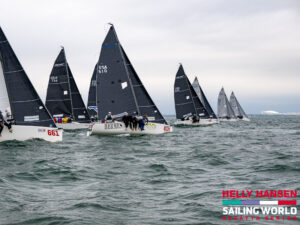
David Curtis was born and raised in Marblehead, Mass., so it’s safe to say the National Sailing Hall of Fame member can sniff out the early tendrils of the summer sea breeze before the next guy. If you find yourself on the same side of the racecourse, consider yourself in good company. Just catch him if you can. For our visiting Sperry Top-Sider NOOD Regatta sailors, here’s Curtis’ Marblehead local knowledge brief:
On a typical Marblehead midsummer day you’ll wake up in the morning with light winds and boats in the harbor aiming west or northwest, toward the town side of harbor. The guy responsible for lining up all the boats perfectly does a good job.
Then, as sure as the sun is going to come out, the wind will clock around all morning long. By the time you’re leaving the harbor, it’ll be a beat to the racecourse. The strength of the sea breeze, of course, will depend on how hot it is and the amount of cloud cover. If it’s a strong northwest gradient breeze, you might have a northwesterly most of the day, but it will diminish as the land gets heated. This direction, however, is pretty uncommon in July.
Our sea breeze can be as far left as 100 degrees and as far right as 280. Quite often, when the sea breeze starts taking over it will go left initially. If a typical sea breeze builds to 260, then later in the day, at around 2:30 to 3:00, it will start going to the right. That’s normal, but remember … nothing’s really normal in Marblehead.
In the early phases of the sea breeze you’ll start to see cumulus clouds overland. If you see those early, say at 11:30, you know for sure you’ll get the sea breeze. If you don’t see those clouds by midday, then the sea breeze tends to take a far longer time to fll and it won’t be as strong.
If you’re on the outside circle, you have a few more options go-ing upwind because you’re further away from land to start with. Overall, you’re pretty safe going left early in any sea breeze direction because left gets you away from land faster. Even if the right is better, it seems the left usually pays because it gets you away from the Neck, no matter which circle you’re on. If I’m unsure which way the wind will go, I’ll start to windward and hold starboard tack as long as I can. In general, if you go out to the left and start getting headed, just go a bit more. There will be more pressure and shift. Later in the day, say after 2:30 p.m., you have to make a choice of when it’s good to go right.
On the downwind legs, it’s the same rules as the early beats—you want to stay away from the shore. You don’t want to jibe to starboard out of the mark and parallel the shore. You’ll eventually run out of the breeze and have a hard time getting back to the mark. I prefer to carry on starboard jibe and come in later on the long port layline to the bottom mark. It’s good to be to the right downwind for pressure and clear air from the other classes coming up the course.
Unless it’s a really strong tide cycle I don’t worry too much about current. When it’s coming in it’s simply flowing toward Boston. When it’s going out, it’s doing the opposite. Usually the Tinker Line is free of current going in and out of Marblehead Harbor, so there are no real current issues there. Just know which way it’s flowing so you know how to compensate for your mark laylines and starts.
On the outside circle, however, you can get into some pretty big current lanes, but you have to have a long course to really get into them. You can see them on the water, and they do make a big difference, but they’re not always there in the same fashion. As a whole, it’s much more important to play the wind over the current.









